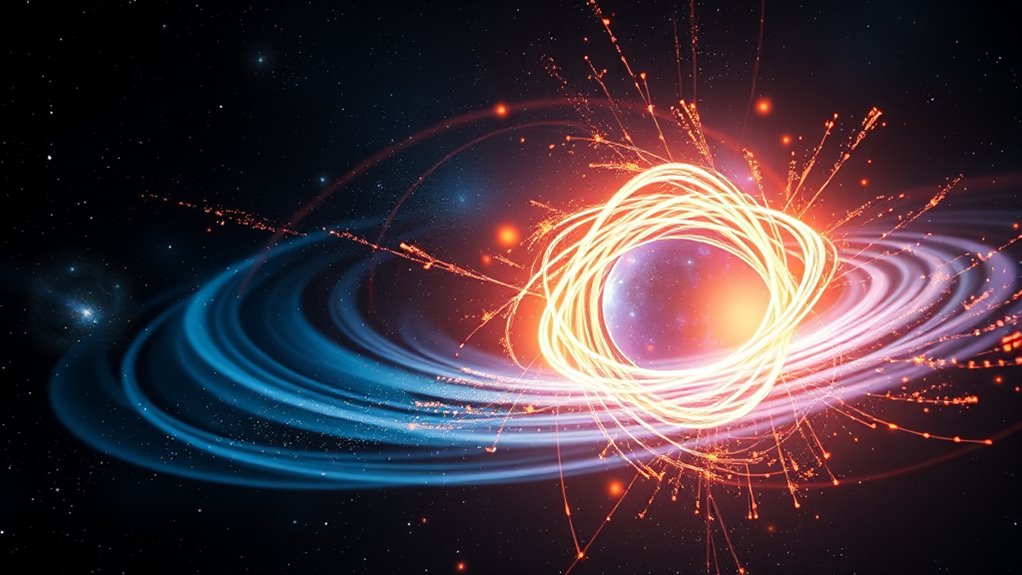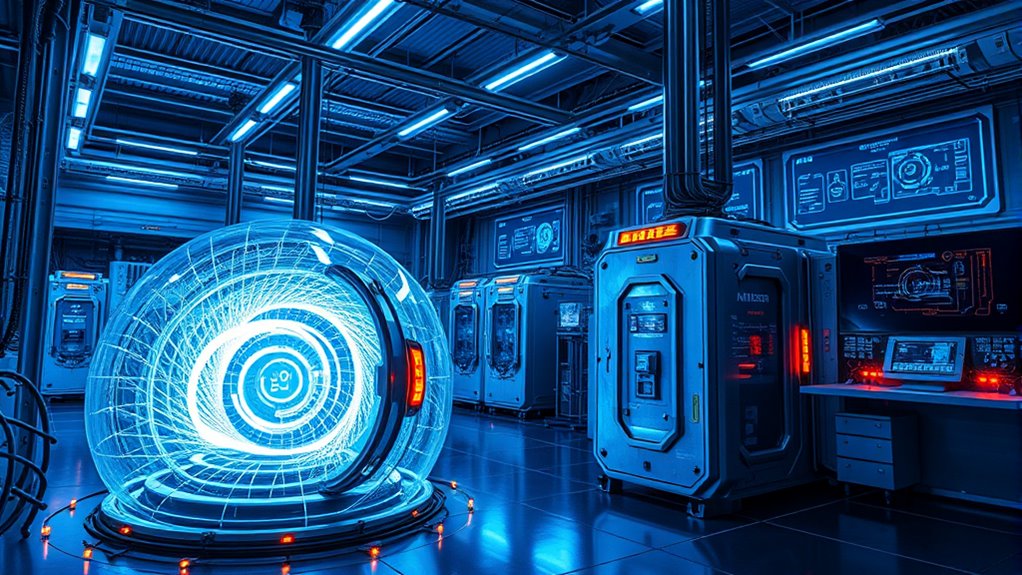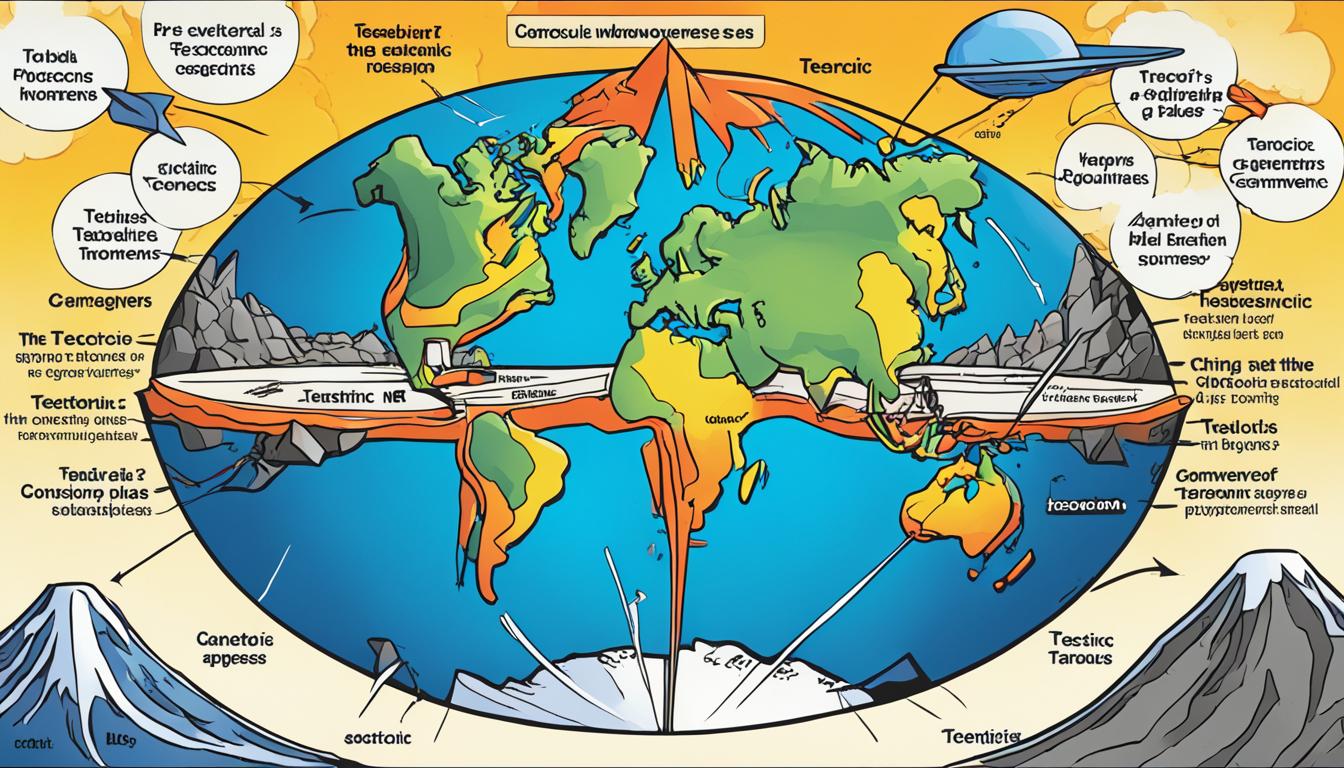Antimatter hasn’t destroyed the universe because it’s extremely rare and mostly confined by natural laws, preventing widespread collisions with normal matter. Although antimatter releases enormous energy when coming into contact with matter, the universe’s composition, dark matter, and cosmic rays keep it in check, avoiding catastrophic explosions. If antimatter were abundant, we’d see constant gamma-ray signals and widespread destruction. Want to understand how cosmic processes keep antimatter in check? Keep exploring to find out more.
Key Takeaways
- Antimatter is extremely rare in the universe, preventing widespread annihilation events.
- Large-scale gamma-ray signals from antimatter-matter collisions are not observed, indicating limited interactions.
- Dark matter’s dominance suggests the universe is matter-rich, with antimatter confined or scarce.
- Cosmic rays contain only tiny amounts of antimatter, reducing the risk of catastrophic annihilations.
- The universe’s stability is maintained by the rarity and containment of antimatter, avoiding destructive explosions.

Have you ever wondered what the universe would look like if matter and antimatter collided? It’s a captivating thought because, theoretically, such collisions release enormous amounts of energy, resulting in explosions of gamma rays. If antimatter were abundant and mixed freely with matter everywhere, the universe would be a very different, much more destructive place. Yet, somehow, it isn’t. That’s because antimatter isn’t spread evenly across the cosmos, and one reason for this is the universe’s composition—dominated by dark matter and cosmic rays—that keeps matter and antimatter largely apart. Dark matter, which makes up about 27% of the universe’s mass-energy, doesn’t interact with light or normal matter in the usual ways. Instead, it influences the behavior of galaxies and the large-scale structure of the universe through gravity. Its presence hints at a universe filled mainly with matter, not antimatter, because if antimatter were equally prevalent, the cosmic landscape would look very different. Cosmic rays, high-energy particles traveling through space, also help maintain this imbalance. These rays include protons, electrons, and atomic nuclei, and some are believed to originate from violent astrophysical events like supernovae or black hole activity. Interestingly, these cosmic rays can sometimes contain antimatter particles—antiprotons and positrons—but their numbers are tiny compared to regular matter. This scarcity suggests that antimatter is not widespread but confined to specific regions or produced in rare events. The interactions of cosmic rays with dark matter might also influence how antimatter is produced or preserved in the universe. If antimatter were abundant, cosmic rays would be constantly annihilating with matter, creating a flood of gamma rays detectable by our telescopes, yet we observe only faint signals. This indicates that antimatter isn’t floating around freely in large quantities. Instead, the universe seems to be made mainly of matter, with antimatter mostly created in controlled environments like particle accelerators or during cosmic events that produce minuscule amounts. The absence of widespread antimatter and the small quantities of antimatter in cosmic rays help prevent catastrophic annihilations on a cosmic scale. This delicate balance allows the universe to evolve without self-destruction. So, while antimatter exists and can annihilate matter spectacularly, it’s confined, rare, and not enough to threaten the universe’s stability. The cosmic landscape, shaped by dark matter and the behavior of cosmic rays, keeps antimatter in check, ensuring that the universe’s grand structure remains intact rather than collapsing into chaos. Additionally, ongoing research into vetted antimatter detection aims to uncover more about its origins and distribution in the universe.
Frequently Asked Questions
Can Antimatter Be Safely Stored on Earth?
You might wonder if antimatter can be safely stored on Earth. It can, thanks to advanced magnetic containment and strict safety protocols. Scientists use powerful magnetic fields to keep antimatter away from matter, preventing dangerous reactions. Safety measures guarantee minimal risk during handling and storage. While challenging, these techniques make it possible to work with antimatter safely, opening doors for research without threatening our planet’s safety.
How Is Antimatter Produced in Laboratories?
Think of antimatter synthesis as a delicate dance where particles and antiparticles are carefully coaxed into existence. In laboratory production, scientists use powerful particle accelerators to collide atoms at high speeds, producing antimatter through energy conversion. These collisions generate antiparticles, like positrons and antiprotons, which are then captured and studied. This process allows us to understand antimatter better and explore its potential applications.
Does Antimatter Have Any Practical Applications Today?
You might wonder if antimatter has practical uses today. It does, especially in antimatter medical applications like PET scans, which help diagnose diseases. Researchers also explore antimatter propulsion, promising faster space travel in the future. While antimatter isn’t widely available yet, these applications show its potential to revolutionize medicine and space exploration, making it an exciting area of scientific development with real-world benefits.
What Is the Difference Between Antimatter and Dark Matter?
Imagine antimatter as nature’s perfect mirror, embodying antimatter symmetry, where each particle has an opposite. Dark matter, however, is like an invisible force field—it’s the dark side of the universe’s mass, distinguished by its gravitational pull. You see, antimatter interacts with light and matter directly, while dark matter’s distinction lies in its unseen influence, shaping galaxies without emitting or absorbing light.
Could Antimatter Be Used as a Future Energy Source?
You might wonder if antimatter could be a future power source. It’s incredibly efficient because antimatter energy releases a vast amount of energy when it meets matter. However, producing and storing antimatter is costly and risky. While it holds potential for future power, current technology isn’t advanced enough. Still, scientists continue exploring antimatter energy to see if it can someday revolutionize energy generation safely and sustainably.
Conclusion
So, even though antimatter has the potential to be a cosmic wrecking ball, it’s kept in check by the universe’s delicate balance. Think of it as a hidden dance, where matter and antimatter rarely collide, avoiding a destructive fireworks display. This balance is what keeps our universe from turning into a blank slate. As long as this cosmic choreography continues, the universe stays intact—like a fragile glass, beautifully held together by unseen forces.










